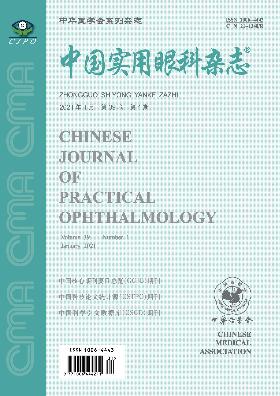结膜切口鞋带连续缝合预防术后浅前房的效果分析
引用次数: 0
摘要
目的分析结膜切口鞋带连续缝合对预防术后浅前房的效果。方法选取2011年3月至2016年3月间行青光眼小梁切除术的原发性青光眼患者41例(82眼)。随机选取1只眼,用鞋带连续缝合将结缔组织瓣贴附于角膜上,作为观察组;另一只眼采用相同的手术方法,但采用结缔组织间断缝合,作为对照组。术后3天、1周、1个月测量眼压(IOP)和前房深度。结果观察组患者术后3 d眼压控制成功38眼,部分眼压控制成功3眼,控制率100%;术后1周和1个月,眼压控制成功37眼,部分控制成功3眼,眼压控制失败1眼,控制率为97.56%。对照组术后3 d成功控制眼压39眼,部分控制眼压2眼,控制率100%;术后1周,眼压控制成功38眼,部分控制成功2眼,未能控制1眼,控制率为97.56%;术后1个月,成功控制眼压37眼,部分控制眼压2眼,未能控制眼压2眼,控制率95.12%。两组间差异无统计学意义(P >0.05)。观察组6只眼(6/41,14.63%)术后3 d出现I度浅前房,均在1周内恢复,无需治疗,术后1个月病情稳定;对照组术后出现浅前房12眼(12/41,29.26%),明显多于观察组(χ2=18.76, P <0.01)。其中,I度浅前房6只眼,II度浅前房4只眼,III度浅前房1只眼。对照组II、III度浅前房发生率(5/41,12.19%)明显高于观察组(0/41)(χ2=24.4, P <0.01)。对照组患者治疗后1 ~ 2周眼恢复,术后稳定。结论结膜切口鞋带连续缝合可预防术后早期浅前房。关键词:鞋带连续缝合;小梁切除术;前房本文章由计算机程序翻译,如有差异,请以英文原文为准。
Analysis of the effect of shoelace continuous suture for conjunctival incision on preventing postsurgical shallow anterior chamber
Objective
To analyze the effect of shoelace continuous suture for conjunctival incision on preventing postsurgical shallow anterior chamber.
Methods
Forty-one patients (82 eyes) diagnosed as primary glaucoma, and treated with trabeculectomy were included in this study during the period from March 2011 to March 2016. One eye, which was randomly chosen and applied shoelace continuous suture to attach the conjuctival fornix flap to the cornea, was included in observation group; the other eye, which under went same surgical procedure but applied conjuctival interrupted suture, was included in the control group. Intraocular pressure (IOP) and anterior chamber depth was measured and recorded after 3 days, 1 week and 1 month after surgery.
Results
Among the observation group, 3 days after surgery, IOP of 38 eyes was successfully controlled, IOP of 3 eyes was partially successfully controlled, with control rate as 100%; 1 week and 1 month after surgery, IOP of 37 eyes was successfully controlled, IOP of 3 eyes was partially successfully controlled, IOP of 1 eye was failed to control, with control rate as 97.56%. Among the control group, 3 days after surgery, IOP of 39 eyes was successfully controlled, IOP of 2 eyes was partially successfully controlled, with control rate as 100%; 1 week after surgery, IOP of 38 eyes was successfully controlled, IOP of 2 eyes was partially successfully controlled, IOP of 1 eye was failed to control, with control rate as 97.56%; 1 month after surgery, IOP of 37 eyes was successfully controlled, IOP of 2 eyes was partially successfully controlled, IOP of 2 eye was failed to control, with control rate as 95.12%. No significant difference was observed between two groups (P >0.05). Six eyes (6/41, 14.63%) had I degree shallow anterior chamber 3 days after surgery among the observation group, all recovered within 1 week without treatment, and remained stabilized 1 month after surgery; 12 eyes with shallow anterior chamber after surgery occurred in control group (12/41, 29.26%), significantly more than the observe group (χ2=18.76, P <0.01). Among them, 6 eyes had I degree shallow anterior chamber, 4 II degree shallow anterior chamber, and 1 III degree shallow anterior chamber. There were significantly more II and III degree shallow anterior chamber occurred in the control group (5/41, 12.19%) than observe group (0/41) (χ2=24.4, P <0.01). Eyes in the control group were recovered within 1-2 week after treatment, and stabilized after that.
Conclusions
Shoelace continu-ous suture for conjunctival incision can help preventing early stage postsurgical shallow anterior chamber.
Key words:
Shoelace continuous suture; Trabeculectomy; Anterior chamber
求助全文
通过发布文献求助,成功后即可免费获取论文全文。
去求助
来源期刊
自引率
0.00%
发文量
9101
期刊介绍:
China Practical Ophthalmology was founded in May 1983. It is supervised by the National Health Commission of the People's Republic of China, sponsored by the Chinese Medical Association and China Medical University, and publicly distributed at home and abroad. It is a national-level excellent core academic journal of comprehensive ophthalmology and a series of journals of the Chinese Medical Association.
China Practical Ophthalmology aims to guide and improve the theoretical level and actual clinical diagnosis and treatment ability of frontline ophthalmologists in my country. It is characterized by close integration with clinical practice, and timely publishes academic articles and scientific research results with high practical value to clinicians, so that readers can understand and use them, improve the theoretical level and diagnosis and treatment ability of ophthalmologists, help and support their innovative development, and is deeply welcomed and loved by ophthalmologists and readers.

 求助内容:
求助内容: 应助结果提醒方式:
应助结果提醒方式:


